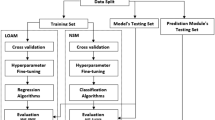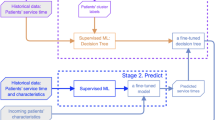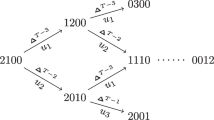Abstract
Data availability enables clinics to use predictive analytics to improve appointment scheduling and overbooking decisions based on the predicted likelihood of patients missing their appointment (no-shows). Analyzing data using machine learning can uncover hidden patterns and provide valuable business insights to devise new business models to better meet consumers’ needs and seek a competitive advantage in healthcare. The innovative application of machine learning and analytics can significantly increase the operational efficiency of online scheduling. This study offers an intelligent, yet explainable, analytics framework in scheduling systems for primary-care clinics considering individual patients’ no-show rates that may vary for each appointment day and time while generating appointment and overbooking decisions. We use the predicted individual no-show rates in two ways: (1) a probability-based greedy approach to schedule patients in time slots with the lowest no-show likelihood, and (2) marginal analysis to identify the number of overbookings based on the no-show probabilities of the regularly-scheduled patients. We find that the summary measures of profit and cost are considerably improved with the proposed scheduling approach as well as an increase in the number of patients served due to a substantial decrease in the no-show rate. Sensitivity analysis confirms the effectiveness of the proposed dynamic scheduling framework even further.









Similar content being viewed by others
Data availability
The dataset generated for the current study is not available to the general public, since it contains confidential data obtained through a license by the authors.
References
Alaeddini, A., Yang, K., Reddy, C., & Yu, S. (2011). A probabilistic model for predicting the probability of no-show in hospital appointments. Health Care Management Science, 14(2), 146–157.
American Academy of Family Physicians. (2021). Primary care. Retrieved 12 May 2022 from http://www.aafp.org/about/policies/all/primary-care.html.
Bailey, N. T. J. (1952). A study of queues and appointment times in hospital out-patient departments, with special reference to waiting-times. Journal of the Royal Statistical Society Series B, 14(2), 185–199.
Ballou-Nelson, P. (2018). How long are patients waiting for an appointment? MGMA Stat. Retrieved 5 October 2022 from https://www.mgma.com/data/data-stories/how-long-are-patients-waiting-for-an-appointment#:~:text=For primary care single specialties, new patients is 6.3 days.
Bean, A. G., & Talaga, J. (1995). Predicting appointment breaking. Journal of Health Care Marketing, 15(1), 29–34.
Berg, B. P., Murr, M., Chermak, D., Woodall, J., Pignone, M., Sandler, R. S., & Denton, B. T. (2013). Estimating the cost of no-shows and evaluating the effects of mitigation strategies. Medical Decision Making, 33(8), 976–985.
Brenner, S., Zeng, Z., Liu, Y., Wang, J., Li, J., & Howard, P. K. (2010). Modeling and analysis of the emergency department at University of Kentucky Chandler Hospital using simulations. Journal of Emergency Nursing, 36(4), 303–310.
Cayirli, T., & Veral, E. (2003). Outpatient scheduling in health care: A review of literature. Production and Operations Management, 12(4), 519–549.
Cayirli, T., Veral, E., & Rosen, H. (2008). Assessment of patient classification in appointment system design. Production and Operations Management, 17(3), 338–353.
Cayirli, T., & Yang, K. K. (2014). A universal appointment rule with patient classification for service times, no-shows, and walk-ins. Service Science, 6(4), 274–295.
Cayirli, T., Yang, K. K., & Quek, S. A. (2012). A universal appointment rule in the presence of no-shows and walk-ins. Production and Operations Management, 21(4), 682–697.
Chen, R. R., & Robinson, L. W. (2014). Sequencing and scheduling appointments with potential call-in patients. Production and Operations Management, 23(9), 1522–1538.
Daggy, J., Lawley, M., Willis, D., Thayer, D., Suelzer, C., DeLaurentis, P. C., Turkcan, A., Chakraborty, S., & Sands, L. (2010). Using no-show modeling to improve clinic performance. Health Informatics Journal, 16(4), 246–259.
Delen, D., Topuz, K., & Eryarsoy, E. (2020). Development of a Bayesian belief network-based DSS for predicting and understanding freshmen student attrition. European Journal of Operational Research, 281(3), 575–587.
De los Rios, I. C., & Charnley, F. J. S. (2017). Skills and capabilities for a sustainable and circular economy: The changing role of design. Journal of Cleaner Production, 160, 109–122.
Dobson, G., Hasija, S., & Pinker, E. J. (2011). Reserving capacity for urgent patients in primary care. Production and Operations Management, 20(3), 456–473.
Dogru, A. K., & Melouk, S. H. (2019). Adaptive appointment scheduling for patient-centered medical homes. Omega—the International Journal of Management Science, 85, 166–181.
Feldman, J., Liu, N., Topaloglu, H., & Ziya, S. (2014). Appointment scheduling under patient preference and no-show behavior. Operations Research, 62(4), 794–811.
Ferro, D. B., Brailsford, S., Bravo, C., & Smith, H. (2020). Improving healthcare access management by predicting patient no-show behavior. Decision Support Systems, 138, 113398.
Fone, D., Hollinghurst, S., Temple, M., Round, A., Lester, N., Weightman, A., Roberts, K., Coyle, E., Bevan, G., & Palmer, S. (2003). Systematic review of the use and value of computer simulation modelling in population health and health care delivery. Journal of Public Health, 25(4), 325–335.
Gerchak, Y., Gupta, D., & Henig, M. (1996). Reservation planning for elective surgery under uncertain demand for emergency surgery. Management Science, 42(3), 321–334.
Glowacka, K. J., Henry, R. M., & May, J. H. (2009). A hybrid data mining/simulation approach for modelling outpatient no-shows in clinic scheduling. Journal of the Operational Research Society, 60(8), 1056–1068.
Green, L. V., & Savin, S. (2008). Reducing delays for medical appointments: A queueing approach. Operations Research, 56(6), 1526–1538.
Gupta, D., & Denton, B. (2008). Appointment scheduling in health care: Challenges and opportunities. IIE Transactions, 40(9), 800–819.
Gupta, S., & Kim, H. W. (2008). Linking structural equation modeling to Bayesian networks: Decision support for customer retention in virtual communities. European Journal of Operational Research, 190(3), 818–833.
Gurol-Urganci, I., de Jongh, T., Vodopivec-Jamsek, V., Atun, R., & Car, J. (2013). Mobile phone messaging reminders for attendance at healthcare appointments. Cochrane Database of Systematic Reviews, 2013(12), DC007458. https://doi.org/10.1002/14651858.CD007458.pub3
Harris, S. L., & Samorani, M. (2020). On selecting a probabilistic classifier for appointment no-show prediction. Decision Support Systems, 142, 113472.
Hassin, R., & Mendel, S. (2008). Scheduling arrivals to queues: A single-server model with no-shows. Management Science, 54(3), 565–572.
Ho, C.-J., & Lau, H.-S. (1992). Minimizing total cost in scheduling outpatient appointments. Management Science, 38(12), 1750–1764.
Huang, Y., & Zuniga, P. (2012). Dynamic overbooking scheduling system to improve patient access. Journal of the Operational Research Society, 63(6), 810–820.
Hung, G. R., Whitehouse, S. R., O’Neill, C., Gray, A. P., & Kissoon, N. (2007). Computer modeling of patient flow in a pediatric emergency department using discrete event simulation. Pediatric Emergency Care, 23(1), 5–10.
Jacobson, S. H., Hall, S. N., & Swisher, J. R. (2013). Discrete-event simulation of health care systems. In R. Hall (Ed.), Patient flow: Reducing delay in healthcare delivery (2nd ed., pp. 273–309). Springer.
Jiang, B., Tang, J., & Yan, C. (2019). A stochastic programming model for outpatient appointment scheduling considering unpunctuality. Omega—the International Journal of Management Science, 82, 70–82.
Jiang, R., Shen, S., & Zhang, Y. (2017). Integer programming approaches for appointment scheduling with random no-shows and service durations. Operations Research, 65(6), 1638–1656.
Johnson, B. J., Mold, J. W., & Pontious, J. M. (2007). Reduction and management of no-shows by family medicine residency practice exemplars. Annals of Family Medicine, 5(6), 534–539.
Kaandorp, G. C., & Koole, G. (2007). Optimal outpatient appointment scheduling. Health Care Management Science, 10(3), 217–229.
Kheirkhah, P., Feng, Q., Travis, L. M., Tavakoli-Tabasi, S., & Sharafkhaneh, A. (2016). Prevalence, predictors and economic consequences of no-shows. BMC Health Services Research, 16, 13.
Klassen, K. J., & Yoogalingam, R. (2009). Improving performance in outpatient appointment services with a simulation optimization approach. Production and Operations Management, 18(4), 447–458.
Klassen, K. J., & Yoogalingam, R. (2014). Strategies for appointment policy design with patient unpunctuality. Decision Sciences, 45(5), 881–911.
Koller, D., & Friedman, N. (2009). Probabilistic graphical models: Principles and techniques. MIT Press.
Kong, Q., Li, S., Liu, N., Teo, C.-P., & Yan, Z. (2020). Appointment scheduling under time-dependent patient no-show behavior. Management Science, 66(8), 3480–3500.
Kuo, Y. H., Balasubramanian, H., & Chen, Y. (2020). Medical appointment overbooking and optimal scheduling: Tradeoffs between schedule efficiency and accessibility to service. Flexible Services and Manufacturing Journal, 32(1), 72–101.
Kyrimi, E., McLachlan, S., Dube, K., Neves, M. R., Fahmi, A., & Fenton, N. (2021). A comprehensive scoping review of Bayesian networks in healthcare: Past, present and future. Artificial Intelligence in Medicine, 117, 102108.
LaGanga, L. R., & Lawrence, S. R. (2007). Clinic overbooking to improve patient access and increase provider productivity. Decision Sciences, 38(2), 251–276.
LaGanga, L. R., & Lawrence, S. R. (2012). Appointment overbooking in health care clinics to improve patient service and clinic performance. Production and Operations Management, 21(5), 874–888.
Lee, S. J., Heim, G. R., Sriskandarajah, C., & Zhu, Y. (2018). Outpatient appointment block scheduling under patient heterogeneity and patient no-shows. Production and Operations Management, 27(1), 28–48.
Leeftink, G., Martinez, G., Hans, E. W., Sir, M. Y., & Pasupathy, K. S. (2022). Optimising the booking horizon in healthcare clinics considering no-shows and cancellations. International Journal of Production Research, 60(10), 3201–3218.
Li, Y., Tang, S. Y., Johnson, J., & Lubarsky, D. A. (2019). Individualized no-show predictions: Effect on clinic overbooking and appointment reminders. Production and Operations Management, 28(8), 2068–2086.
Liu, J., & KC, D. (2023). Nudging patient choice: Reducing no-shows using waits framing messaging. Operations Research, 71(3), 1004–1020.
Liu, N. (2016). Optimal choice for appointment scheduling window under patient no-show behavior. Production and Operations Management, 25(1), 128–142.
Liu, N., Ziya, S., & Kulkarni, V. G. (2010). Dynamic scheduling of outpatient appointments under patient no-shows and cancellations. Manufacturing & Service Operations Management, 12(2), 347–364.
Mahjoob, A., Alfadhli, Y., & Omachonu, V. (2023). Healthcare waste and sustainability: Implications for a circular economy. Sustainability, 15(10), 7788.
Mardani, A., Weber, G. W., & Khan, S. A. R. (2022). Guest editorial: Editorial for special issue on the role of big data on the transition to circular economy and sustainable operations management. Journal of Enterprise Information Management, 35(4/5), 949–954.
McLachlan, S., Dube, K., Hitman, G. A., Fenton, N. E., & Kyrimi, E. (2020). Bayesian networks in healthcare: Distribution by medical condition. Artificial Intelligence in Medicine, 107, 101912.
Murray, M. (2005). Answers to your questions about same-day scheduling. Family Practice Management, 12(3), 59–64.
Muthuraman, K., & Lawley, M. (2008). A stochastic overbooking model for outpatient clinical scheduling with no-shows. IIE Transactions, 40(9), 820–837.
Nadkarni, S., & Shenoy, P. P. (2001). A Bayesian network approach to making inferences in causal maps. European Journal of Operational Research, 128(3), 479–498.
Nadkarni, S., & Shenoy, P. P. (2004). A causal mapping approach to constructing Bayesian networks. Decision Support Systems, 38(2), 259–281.
Norris, J. B., Kumar, C., Chand, S., Moskowitz, H., Shade, S. A., & Willis, D. R. (2014). An empirical investigation into factors affecting patient cancellations and no-shows at outpatient clinics. Decision Support Systems, 57, 428–443.
Pan, X., Geng, N., Xie, X., & Wen, J. (2020). Managing appointments with waiting time targets and random walk-ins. Omega—the International Journal of Management Science, 95, 102062.
Patrick, J., Puterman, M. L., & Queyranne, M. (2008). Dynamic multipriority patient scheduling for a diagnostic resource. Operations Research, 56(6), 1507–1525.
Pearl, J. (2014). Probabilistic reasoning in intelligent systems: Networks of plausible inference. Elsevier.
Rajagopalan, S., Pronovost, P., & Al-Kindi, S. (2023). Implementing a sustainability framework in healthcare: A three-lens framework. Healthcare, 11(13), 1867.
RelyMD. (2019). Average wait times to see a doctor. Retrieved 5 October 2022 from https://relymd.com/blog-infographic-average-wait-times-to-see-a-doctor/.
Rising, E. J., Baron, R., & Averill, B. (1973). A systems analysis of a university-health-service outpatient clinic. Operations Research, 21(5), 1030–1047.
Robinson, L. W., & Chen, R. R. (2010). A comparison of traditional and open-access policies for appointment scheduling. Manufacturing & Service Operations Management, 12(2), 330–346.
Saghafian, S., Trichakis, N., Zhu, R., & Shih, H. A. (2023). Joint patient selection and scheduling under no-shows: Theory and application in proton therapy. Production and Operations Management, 32(2), 547–563.
Salzarulo, P. A., Mahar, S., & Modi, S. (2016). Beyond patient classification: Using individual patient characteristics in appointment scheduling. Production and Operations Management, 25(6), 1056–1072.
Samorani, M., & Ganguly, S. (2016). Optimal sequencing of unpunctual patients in high-service-level clinics. Production and Operations Management, 25(2), 330–346.
Samorani, M., & LaGanga, L. R. (2015). Outpatient appointment scheduling given individual day-dependent no-show predictions. European Journal of Operational Research, 240(1), 245–257.
Simsek, S., Dag, A., Tiahrt, T., & Oztekin, A. (2021). A Bayesian Belief Network-based probabilistic mechanism to determine patient no-show risk categories. Omega—the International Journal of Management Science, 100, 102296.
Simsek, S., Tiahrt, T., & Dag, A. (2020). Stratifying no-show patients into multiple risk groups via a holistic data analytics-based framework. Decision Support Systems, 132, 113269.
Srinivas, S., & Ravindran, A. R. (2018). Optimizing outpatient appointment system using machine learning algorithms and scheduling rules: A prescriptive analytics framework. Expert Systems with Applications, 102, 245–261.
Stein, C., Troung, V.-A., & Wang, X. (2020). Advance service reservations with heterogeneous customers. Management Science, 66(7), 2929–2950.
Sviokla, J., Schroeder, B., & Weakland, T. (2010). How behavioral economics can help cure the health care crisis. Harvard Business Review. Retrieved 12 May 2022 from https://hbr.org/2010/03/how-behavioral-economics-can-h.
Topuz, K., & Delen, D. (2021). A probabilistic Bayesian inference model to investigate injury severity in automobile crashes. Decision Support Systems, 150, 113557.
Topuz, K., Jones, B. D., Sahbaz, S., & Moqbel, M. (2021). Methodology to combine theoretical knowledge with a data-driven probabilistic graphical model. Journal of Business Analytics, 4(2), 125–139.
Topuz, K., Uner, H., Oztekin, A., & Yildirim, M. B. (2018). Predicting pediatric clinic no-shows: A decision analytic framework using elastic net and Bayesian belief network. Annals of Operations Research, 263, 479–499.
Troung, V.-A. (2015). Optimal advance scheduling. Management Science, 61(7), 1584–1597.
Tyler, D. C., Pasquariello, C., & Chen, C. H. (2003). Determining optimum operating room utilization. Anesthesia & Analgesia, 96(4), 1114–1121.
Wang, D., Muthuraman, K., & Morrice, D. (2019). Coordinated patient appointment scheduling for a multistation healthcare network. Operations Research, 67(3), 599–618.
Wang, S., Liu, N., & Wan, G. (2020). Managing appointment-based services in the presence of walk-in customers. Management Science, 66(2), 667–686.
Welch, J. D., & Bailey, N. T. J. (1952). Appointment systems in hospital outpatient departments. The Lancet, 259(6718), 1105–1108.
Zacharias, C., & Armony, M. (2017). Joint panel sizing and appointment scheduling in outpatient care. Management Science, 63(11), 3978–3997.
Zacharias, C., & Pinedo, M. (2014). Appointment scheduling with no-shows and overbooking. Production and Operations Management, 23(5), 788–801.
Zacharias, C., & Yunes, T. (2020). Multimodularity in the stochastic appointment scheduling problem with discrete arrival epochs. Management Science, 66(2), 744–763.
Zeng, B., Turkcan, A., Lin, J., & Lawley, M. (2010). Clinic scheduling models with overbooking for patients with heterogeneous no-show probabilities. Annals of Operations Research, 178, 121–144.
Zeng, Z., Ma, X., Hu, Y., Li, J., & Bryant, D. (2012). A simulation study to improve quality of care in the emergency department of a community hospital. Journal of Emergency Nursing, 38(4), 322–328.
Zhan, Y., & Zhang, Z. (2023). A study on pre-charging strategy for appointment scheduling problem with no-shows. Journal of the Operational Research Society, 74(3), 811–825.
Funding
None. This research did not receive any specific grant from funding agencies in the public, commercial, or not-for-profit sectors.
Author information
Authors and Affiliations
Corresponding author
Ethics declarations
Conflict of interest
The authors declare that they have no conflict of interest.
Ethical approval
This article does not contain any studies with human participants or animals performed by any of the authors. The dataset generated for the current study is not available to the general public, since it contains confidential data obtained through a license by the authors.
Additional information
Publisher's Note
Springer Nature remains neutral with regard to jurisdictional claims in published maps and institutional affiliations.
Supplementary Information
Below is the link to the electronic supplementary material.
Rights and permissions
Springer Nature or its licensor (e.g. a society or other partner) holds exclusive rights to this article under a publishing agreement with the author(s) or other rightsholder(s); author self-archiving of the accepted manuscript version of this article is solely governed by the terms of such publishing agreement and applicable law.
About this article
Cite this article
Topuz, K., Urban, T.L., Russell, R.A. et al. Decision support system for appointment scheduling and overbooking under patient no-show behavior. Ann Oper Res 342, 845–873 (2024). https://doi.org/10.1007/s10479-023-05799-0
Received:
Accepted:
Published:
Issue Date:
DOI: https://doi.org/10.1007/s10479-023-05799-0




